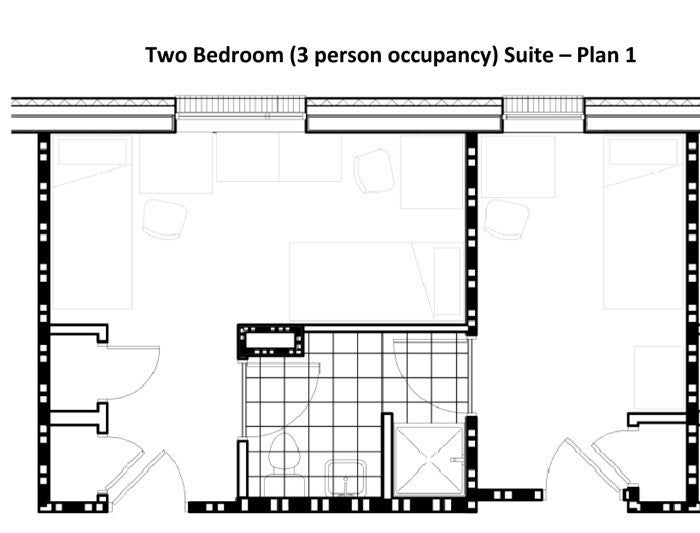
When I was a college freshman in the early 1990s, I lived in a dorm that was as sterile as a hospital room, a 193-square-foot box with white cinderblock walls that I shared with two other guys. The bathroom was also shared — with an entire floor.
Such basic living quarters greeted generations of college students before me. For much of the history of American higher education, dorms and other student amenities — from dining halls to recreational centers — were an afterthought to the primary business of campus planning: grand academic buildings. In fact, in the 1840s, the president of Brown University described dorm life as “unnatural” and blamed student housing for most of the evils of college life. Brown and Columbia University even attempted to eliminate dorms from their campuses. While that move ultimately proved unsuccessful, student housing and other facilities that supported student life on most campuses remained a fairly spartan experience up until the 1990s.
By the turn of this century, colleges had an increasing appetite for campus luxuries. A surge of students from the millennial generation were graduating from high schools nationwide, and many colleges found the simplest way to compete for attention in a crowded market was to build fancier facilities. Construction cranes became ubiquitous on campuses, and often the most high-profile projects involved student amenities — rock-climbing walls in recreation centers, swanky student unions with first-rate food services, and luxury “residence halls” with private bathrooms — usually financed by borrowing. Between 2001 and 2012, the amount of debt taken on by colleges rose 88 percent, to $307 billion.
“Between 2001 and 2012, the amount of debt taken on by colleges rose 88 percent, to $307 billion.”
Gettysburg College spent $27 million on a 55,000-square-foot recreational center with a bouldering area. Drexel University devoted $45 million to its own 84,000-square-foot recreation center, complete with a walking and jogging track. The University of Memphis paid $50 million for a 169,000-square-foot campus center that houses a theater, food court, and a 24-hour computer lab. Texas Tech University boasts “the largest leisure pool on a college campus in the United States, with a 645-foot-long lazy river as the centerpiece of the design.”
New student fees approved by undergraduates funded the debt for many of these amenities. These were students who, by the time the fees were implemented, had long since graduated, leaving the tab for their successors. Now, after a building boom that lasted more than a decade, the pace of spending on lavish campus frills is slowing. Some 6.6 million square feet of space for dorms and student services opened on campuses in 2015, according to the higher-education construction consulting firm Sightlines, the leanest year for new buildings dedicated to student spaces since the company started tracking construction in 2000. The high point for student amenities came in 2004, when more than 11 million square feet opened.
The reason behind this shift is a combination of growing concerns about rising tuition and student debt, declining numbers of high-school graduates, and the ever-fluctuating tastes of students and parents.
“We don’t see the amenities arms race anymore,” said Susan Fitzgerald, an associate managing director at Moody’s Investors Service, which examines the finances of more than 500 colleges that issue bonds through the public markets. “We’re seeing a move away from trophy buildings as universities prioritize their spending.”
After building one of the country’s most-expensive student-housing projects, a $168 million complex of apartment-style residences called University Commons, in 2007, Georgia State University officials worried about the impact of pricier housing on the ability of students to earn a degree. The university found that for every $5,000 in unmet financial need, a student was 12 percent less likely to graduate.
So Jerry Rackliffe, Georgia State’s vice president for finance and administration, asked the university’s facilities and housing leaders to develop a plan for a simple and tiny dorm-room option that would cost students less than housing in University Commons and include a dining plan (which wasn’t included with the on-campus apartments). “When I first brought this up, the housing folks said it wouldn’t work because every college is building apartment buildings,” Rackliffe said. “We agreed to do a few hundred beds as a test.”
RELATED: Why Men Are the New College Minority
The result was Patton Hall, which opened in 2009. Each room holds three students, with a single bed on one side and two on the other side connected in the middle by a Jack-and-Jill bathroom (private bathrooms save money in housekeeping costs when compared to communal bathrooms). Overall, everything is smaller in Patton Hall: 191 square feet per resident compared to 443 square feet in University Commons. Patton also has a dining hall on the first floor. The cost of Patton’s shared room and an unlimited meal plan is less than the room alone in University Commons.

Floor plan of a Patton Hall suite (Courtesy of GSU)
From the day it opened, the new dorm has filled up faster than other campus housing. Patton Hall was so popular that in 2011 the university converted two local hotels using its basic dorm concept. The rooms “might be tiny, but they still include modern conveniences,” Rackliffe said, such as washers and dryers and lounges on each floor, Wi-Fi, and air conditioning.
Affordability is also driving new housing projects at the University of California’s San Francisco and San Diego campuses. In San Francisco, a shortage of on-campus beds and affordable off-campus housing “threatens enrollment,” said Leslie Santos, the executive director of housing services at UCSF. The San Francisco campus is breaking ground this fall on a new housing complex that reduces square footage per bed by a third in some cases, mostly by eliminating the living room.
“Students are more open to these new living arrangements than we give them credit for,” said Thomas Carlson-Reddig, a partner at Little, an architectural firm that designs a dozen campus projects a year. “If you can get the cost down, students will live in a closet.”
Another reason for colleges withdrawing from the amenities arms race is that higher education is “no longer in a growth mode,” said Fitzgerald of Moody’s, so there are fewer dollars available to build student luxuries. Enrollment numbers in higher education have fallen for five consecutive years. This year alone there were 81,000 fewer high-school graduates nationwide than a year ago. The decline in college-going students has hit small colleges — a sector of higher education that used new dorms and student centers to lure applicants over the last decade — the hardest. Nearly one-third of small colleges operated with a budget deficit last year, according to Moody’s, up from 20 percent three years ago.
New buildings are often the first stop on campus tours for prospective students and their families. Jeff Kallay, who has been hired by dozens of colleges as a consultant to improve their tours and make them more effective in motivating prospective students to apply, said he has seen a shift from “grandiose palaces to niche amenities,” such as gaming lounges for Wii and Xbox. The University of Alabama at Birmingham and Saint Leo University in Florida are among those with elaborate game rooms. “Today’s Generation X parents don’t care as much if their kids suffer in older-style dorms,” said Kallay, the chief executive and cofounder of Render Experiences.
It’s also unclear if the “build it and they will come” approach actually worked in attracting students or keeping them through graduation. “It doesn’t cohere to how students make choices about where to go to college,” said Kevin McClure, an assistant professor of higher education at the University of North Carolina at Wilmington, who studies campus housing.
Take Indiana University of Pennsylvania as an example of a school that made a big bet on amenities to gain students but without success. Late last decade, the state school 60 miles northeast of Pittsburgh replaced all student housing on campus with apartment-style suites, at a cost of $270 million. Since 2010, its undergraduate enrollment has dropped 17 percent to just over 10,000 students.
Even so, for less-selective schools like Indiana University of Pennsylvania, it is usually easier to construct new buildings than improve academic quality, which not only takes longer to achieve but is also less visible to families on tours. That’s the takeaway from a 2015 study from researchers at the University of Michigan, who analyzed a phenomenon they described as “college as country club” and the pressure on schools to cater to students’ desire for “consumption amenities.”
The study found that lower-tier schools “have greater incentive to focus on consumption amenities” because prospective students of less-selective colleges may care more about the “resort” experience of college than teaching and academics. The researchers drew parallels to health care, “where patient amenities are a much stronger driver of hospital demand than clinical quality.” But that analogy is not quite apt since the goal of hospitals is not to keep patients for a specific amount of time, as is the case in higher education where the goal is to keep students until they receive a diploma. Fewer than 40 percent of students enrolling for the first time at a four-year college actually graduate in four years, and many drop out never to return.
“Fewer than 40 percent of students enrolling for the first time at a four-year college actually graduate in four years, and many drop out never to return.”
Some higher-education experts argue that ever-fancier amenities for students distract them from their studies — college students spend only a quarter of their week on academic pursuits—and encourage them to spend time alone in private kitchens and bedrooms rather than with other students in dining halls or lounges. Research shows that without the sense of community that often comes from living together in close communal quarters, students may have fewer opportunities to learn how to get along with different people and manage conflicts, or develop the friendships and networks that keep them in school.
As colleges increasingly worry about boosting their retention and graduation rates, campuses are returning to their old-school ways. The barrack-like communal living of my undergraduate days probably won’t ever return, but dorms and other student amenities are going back to more modest times with the conveniences of the modern age.
This story originally appeared on TheAtlantic.com.
More from The Atlantic: Why Do Women Bully Each Other at Work?, A Dinosaur So Well Preserved, It Looks Like a Statue
